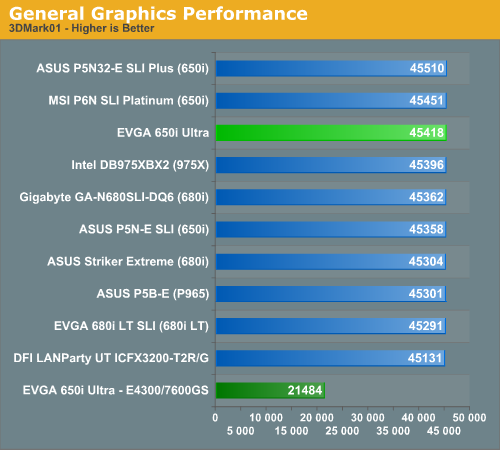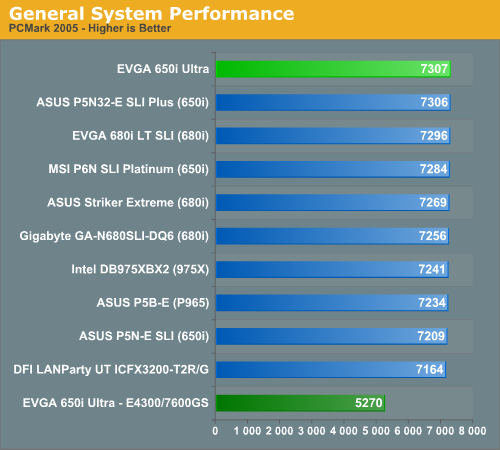EVGA nForce 650i Ultra: Performance on a Budget
by Gary Key on April 10, 2007 2:00 AM EST- Posted in
- Motherboards
Synthetic Graphics Performance
The 3DMark series of benchmarks developed and provided by Futuremark are among the most widely used tools for benchmark reporting and comparisons. Although the benchmarks are very useful for providing apple to apple comparisons across a broad array of GPU and CPU configurations they are not a substitute for actual application and gaming benchmarks. In this sense we consider the 3DMark benchmarks to be purely synthetic in nature but still very valuable for providing consistent measurements of performance.


In our 3DMark06 test, all of board are basically even with only an 89 point separation from first to last. Our EVGA 650i Ultra board scored in the middle of the pack and offered an average video score but a top CPU score in this benchmark. This was just the opposite result from our ASUS and MSI based 650i boards.
In the more memory and CPU sensitive 3DMark01 benchmark we see our EVGA 650i Ultra board scoring in the top three spots. This pattern will continue in the balance of our benchmarks and shows that NVIDIA has properly tuned this board for performance oriented results even though its price is fairly inexpensive.
General System Performance
The PCMark05 benchmark developed and provided by Futuremark was designed for determining overall system performance for the typical home computing user. This tool provides both system and component level benchmarking results utilizing subsets of real world applications or programs. This benchmark is useful for providing comparative results across a broad array of Graphics, CPU, Hard Disk, and Memory configurations along with multithreading results. In this sense we consider the PCMark benchmark to be both synthetic and real world in nature, and it again provides for consistency in our benchmark results.

The EVGA 650i Ultra board tops our previous NVIDIA chipset offerings in this very competitive benchmark and we are starting to see a pattern emerge with the latest board releases performing slightly better than the earlier ones. The 650i and 680i chipsets scored very well on the single task disk benchmarks with the 680i performing slightly better in the graphics subsystem tests where they led the field, although the EVGA 650i tied the LT board in this test. Our 975X and P965 chipset boards won the multitasking tests while the RD600 offered middle of the road performance in majority of tests. Our EVGA board scored better in the multitasking tests than the other NVIDIA boards which propelled it into first place.
The 3DMark series of benchmarks developed and provided by Futuremark are among the most widely used tools for benchmark reporting and comparisons. Although the benchmarks are very useful for providing apple to apple comparisons across a broad array of GPU and CPU configurations they are not a substitute for actual application and gaming benchmarks. In this sense we consider the 3DMark benchmarks to be purely synthetic in nature but still very valuable for providing consistent measurements of performance.


In our 3DMark06 test, all of board are basically even with only an 89 point separation from first to last. Our EVGA 650i Ultra board scored in the middle of the pack and offered an average video score but a top CPU score in this benchmark. This was just the opposite result from our ASUS and MSI based 650i boards.
In the more memory and CPU sensitive 3DMark01 benchmark we see our EVGA 650i Ultra board scoring in the top three spots. This pattern will continue in the balance of our benchmarks and shows that NVIDIA has properly tuned this board for performance oriented results even though its price is fairly inexpensive.
General System Performance
The PCMark05 benchmark developed and provided by Futuremark was designed for determining overall system performance for the typical home computing user. This tool provides both system and component level benchmarking results utilizing subsets of real world applications or programs. This benchmark is useful for providing comparative results across a broad array of Graphics, CPU, Hard Disk, and Memory configurations along with multithreading results. In this sense we consider the PCMark benchmark to be both synthetic and real world in nature, and it again provides for consistency in our benchmark results.

The EVGA 650i Ultra board tops our previous NVIDIA chipset offerings in this very competitive benchmark and we are starting to see a pattern emerge with the latest board releases performing slightly better than the earlier ones. The 650i and 680i chipsets scored very well on the single task disk benchmarks with the 680i performing slightly better in the graphics subsystem tests where they led the field, although the EVGA 650i tied the LT board in this test. Our 975X and P965 chipset boards won the multitasking tests while the RD600 offered middle of the road performance in majority of tests. Our EVGA board scored better in the multitasking tests than the other NVIDIA boards which propelled it into first place.










18 Comments
View All Comments
kentster2 - Wednesday, April 18, 2007 - link
This motherboard sounds perfect for me but I can't find it anywhere. In fact I can't find any boards based on the 650i Ultra chipset available anywhere. I did find the specs on an MSI board based on this chipset but again no availability. Does anyone know when the general availability will be for these boards?yyrkoon - Thursday, April 12, 2007 - link
Still does not compare to the best AM2 'budget' board out there. Add the following, and it would do good I think:1) Heatpipe cooled chipset
2) Either one more PATA port, or 2 more SATA ports for a total of 8 drives
3) Firewire ( not supported ?! )
4) Overclocking options out the wazzu, with memeory voltages capable of 3.0v
Are the PATA ports controlled by the 430MCP ? It seems that way, going by the features list. If this is the case, WHY leave out a PATA port ? It does not make sense. These four things I've mentioned above are not too much to ask, ABIT has already proven that with the NF-M2 nView, and places like newegg, ZZF, etc can not seem to keep these boards in stock ! What gives . . .
kmmatney - Wednesday, April 11, 2007 - link
it;s obvious that having a high priced sound card will help out with frame rates, but what about a cheaper card? Would a $27 Creative Audigy SE provide the same speed benefits by taking the load from the cpu?Gary Key - Wednesday, April 11, 2007 - link
The SE will provide frame rates that are on average about 2~3% worse than the X-FI in my experiences.lopri - Tuesday, April 10, 2007 - link
Gary's measure is remarkably similar to my observations on EVGA 680i board. (Interesting because the chips used on the 680i SLI are different from 650i Ultra) Without active cooling, I saw SPP temp rising to 100C(!) and MCP to 80C. This will not only cause instability (especially mated with other high-end components) but likely shorten the lifespan of the board. Even more worrisome is that the ever-increasing popularity of those L-shaped HSFs. These HSFs provide practically zero air-flow on the board's hot (i mean, HOT) spots and therefore the heat keeps building up.
I think NV at this point just assume that their target audience are *enthusiasts* in that:
1. Enthusiasts today just accept that a new motherboard/chipset is basically a beta product and expect fix/patches via BIOS updates and/or hardware revision.
2. Enthusiasts tend to employ their own cooling solution anyway.
And that's exactly what I've done up to this date. Every single NV chipset board I bought the first thing I did was replacing stock chipset/VRM cooling with aftermarket stuff.
And I'M TIRED OF IT.
This board may be selling for $99, but in order for you to build your main rig with a peace of mind on it, you will need an aftermarket cooling for the missing SB HSF (how dare they leave it wide open like that is beyond me) and the paltry NB heatsink for a heavier one. There goes extra $20~30 quite easily.
To my eyes, this board cut so many corners and definitely not worth $99. $70~80 maybe. And I do think that's how much it'll sell for in less than a month.
nullpointerus - Wednesday, April 11, 2007 - link
When it's included, active cooling's crap anyway. The little NB/SB fans last a few months at most before giving out completely. Motherboard makers should get in touch with Zalman or somebody like them and get some decent quality HSF's on these boards.jay401 - Wednesday, April 11, 2007 - link
Totally agree! It would be stupid to buy a motherboard that requires you buy other items just to ensure stable operation and longevity.Scarceas - Tuesday, April 10, 2007 - link
Really, who needs 2.2V? If you have RAM that needs that much voltage, chances are you paid more money for it, and the board you are looking to use it with will probably not be a budget board.WT - Tuesday, April 10, 2007 - link
I have an eVGA N41 board, so I want to like this thing, but looking at this 650 board .. blechhh .. talk about plain Jane !! It looks like a straight reference board or an Intel board ! Regardless of looks, performance is what we want, so I would refer anyone looking at this board to read Anand's earlier article on the MSI P6N Platinum and see if that isn't a better fit for your needs. The extra $40-50 is well justified (in my case at least) with the better cooling setup on the MSI board as well as Firewire (just bought a miniDV camcorder) so give that a read as well.If the MSI Plat is priced too high, then check out the FI board priced at $108 at popular vendors websites.
Pirks - Tuesday, April 10, 2007 - link
Gary, E6300 has TWO megabytes of cache, not FOUR